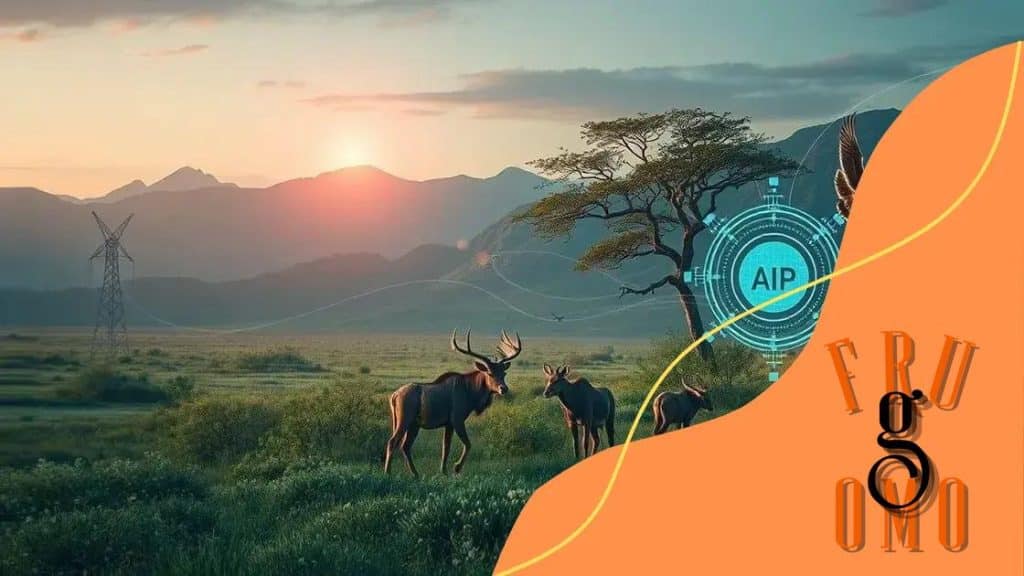AI in wildlife conservation efforts is changing lives

AI in wildlife conservation efforts significantly enhances monitoring, data analysis, and protection of endangered species through innovative technologies like drones, machine learning, and community engagement.
AI in wildlife conservation efforts is transforming how we protect our planet’s biodiversity. With cutting-edge technology, conservationists are uncovering new ways to monitor wildlife, predict threats, and enhance preservation strategies. Imagine the difference we can make together!
The role of AI in tracking endangered species
Understanding the role of AI in tracking endangered species has never been more crucial. Conservationists are increasingly leveraging technology to monitor wildlife populations effectively. By integrating AI, we can achieve significant advancements in how we collect and analyze data.
How AI Tracks Endangered Species
AI algorithms are capable of processing large volumes of data quickly. They analyze patterns in animal behavior, habitats, and migration routes. This data allows conservationists to make informed decisions about protecting various species.
Benefits of Using AI for Wildlife Tracking
- Improved accuracy in monitoring species population.
- Real-time data collection and analysis.
- Enhanced predictive modeling for migration patterns.
- Lower costs and resource savings in tracking efforts.
Furthermore, AI enables the use of remote sensing technologies, such as drones and camera traps. These tools help capture images and footage of wildlife without disturbing their natural habitats. By utilizing AI, we can filter through thousands of images quickly, identifying animals and their behaviors instantly.
This technology not only informs conservation strategies but also raises awareness. Engaging the public through visible data can foster support for endangered species conservation efforts. In turn, this social awareness can lead to greater community involvement in wildlife protection initiatives.
Challenges and Solutions
Despite its benefits, challenges exist in implementing AI for species tracking. Data privacy concerns, technological costs, and the need for specialized skills can hinder progress. However, partnerships between tech companies and conservation organizations can help address these issues by providing resources and expertise.
In conclusion, as we explore new methods for wildlife monitoring, the role of AI in tracking endangered species will continue to grow. Combining technology with wildlife conservation offers hope for preserving our planet’s rich biodiversity.
How AI is improving habitat monitoring
AI is significantly changing how we monitor habitats. With the help of technology, conservationists can track environmental changes more effectively. This includes observing everything from temperature shifts to wildlife interactions.
Advanced Data Collection
One of the key benefits of AI in habitat monitoring is its ability to gather vast amounts of data quickly. Sensors and satellites collect information about various ecosystems in real time. This data provides crucial insights into the health of different habitats.
AI Techniques in Habitat Monitoring
- Using machine learning to analyze ecological data.
- Implementing satellite imagery to assess land use changes.
- Integrating drones for aerial surveys of hard-to-reach areas.
- Employing predictive analytics to forecast environmental threats.
Through these techniques, researchers can detect trends that might indicate distress within an ecosystem. For instance, AI can help identify areas suffering from deforestation or pollution, allowing for timely interventions.
Moreover, AI technologies facilitate collaboration among scientists. By sharing data, experts can create a more comprehensive view of ecosystems worldwide. This collaborative effort strengthens conservation strategies and enhances our collective understanding of biodiversity.
Real-World Applications
Several organizations have already begun using AI for habitat monitoring projects. These initiatives are proving successful in various environments, such as forests, wetlands, and oceans. For example, AI systems can analyze images from camera traps to assess species presence and distribution.
As we embrace these advancements, we recognize the importance of protecting habitats to ensure a thriving ecosystem. The role of AI is vital in making informed decisions for the future of our planet.
Innovative AI technologies in wildlife management

Innovative AI technologies are revolutionizing wildlife management. These advancements help in protecting endangered species and preserving habitats effectively. By integrating technology, conservationists can track species, analyze data, and implement better management strategies.
Types of AI Technologies in Use
Several AI technologies are playing a key role in wildlife management. Machine learning algorithms analyze large datasets collected from various sources, offering insights that guide conservation efforts.
- Predictive modeling identifies potential threats to species and habitats.
- Remote sensing technologies monitor ecosystem changes from above.
- Automated camera traps capture images of wildlife without interference.
- Robotics assist in conducting physical surveys in hard-to-reach areas.
These tools not only enhance the efficiency of data collection but also improve the accuracy of wildlife monitoring. AI technologies allow researchers to identify patterns that may go unnoticed otherwise. For instance, algorithms can detect shifts in animal movements that indicate environmental changes.
Real-World Applications
Many organizations have adopted AI technologies in their wildlife management practices. Projects involving AI are already underway, showcasing significant success in various contexts. Many conservation groups are using drones equipped with cameras to survey protected areas. This method reduces human impact while providing accurate data on wildlife populations.
Moreover, AI technologies facilitate community engagement. By sharing accessible data visuals, local communities can better understand wildlife conservation efforts. This fosters a sense of responsibility and encourages public participation in protecting their ecosystems.
As innovative AI technologies continue to evolve, the landscape of wildlife management will keep transforming, making it possible to conserve biodiversity more effectively than ever before.
Case studies of successful AI conservation projects
Examining case studies of successful AI conservation projects reveals how technology is making a real difference in wildlife protection. These examples demonstrate the power of AI in addressing critical environmental challenges.
Project 1: Protecting Elephants in Africa
One remarkable example involves using AI to combat poaching of elephants. Conservationists developed a system that analyzes drone footage to monitor large wildlife reserves. The AI can identify suspicious activities and alert rangers in real time.
- Benefits include enhanced surveillance of remote areas.
- Increased efficiency in resource allocation for ranger teams.
- Reduction in poaching incidents by over 50%.
This project highlights how technology can augment traditional conservation methods, ultimately saving endangered species.
Project 2: Monitoring Coral Reefs
Another successful case study focuses on coral reef monitoring. AI-driven systems analyze underwater images to assess the health of coral reefs. By identifying areas at risk, researchers can quickly implement protective measures.
The AI processes hundreds of thousands of images more accurately and faster than human divers. This efficiency allows scientists to respond promptly to environmental threats such as bleaching and pollution.
Project 3: Tracking Wildlife Movements
In a different approach, AI has been used to track wildlife movements. Machine learning algorithms process data from GPS collars fitted on animals. This information helps conservationists understand migration patterns and habitat usage.
- Real-time data collection enhances decision-making.
- Insights improve habitat management strategies.
- Facilitates collaboration with other organizations and researchers.
These case studies illustrate the transformative impact of AI on conservation efforts. By leveraging technology, we can protect species and ecosystems more effectively than ever before.
Future trends in AI for wildlife conservation
The future trends in AI for wildlife conservation show great promise. As technology evolves, its applications in conserving biodiversity will become even more significant. Enhanced tools will help researchers and conservationists tackle emerging challenges effectively.
Enhanced Data Analysis
One trend is the improvement in data analysis capabilities. AI algorithms will become more advanced, allowing for deeper insights into wildlife behavior and ecosystem health. By processing complex datasets quickly, AI can identify critical trends that require immediate attention.
- Real-time monitoring will become standard for many species.
- The use of big data will provide comprehensive overviews of ecosystems.
- AI’s predictive capabilities will help in proactive conservation strategies.
This shift towards data-driven approaches will enable conservationists to make more informed decisions.
Increased Collaboration
Another significant trend is increased collaboration across sectors. Conservationists, technologists, and researchers will work together to develop innovative solutions. These partnerships may lead to new AI tools tailored for specific conservation needs.
For example, software created in collaboration with local communities can help protect endangered species in their habitats. Engaging local stakeholders ensures that the tools address practical conservation challenges.
Emerging Technologies
New technologies are also set to influence AI in wildlife conservation. Innovations in robotics, for instance, can improve the efficiency of data collection. Drones will play a larger role, providing aerial surveys that offer comprehensive views of habitats.
- Integration of AR and VR for educational purposes.
- Machine learning will enhance the accuracy of species identification.
- Remote sensing will provide crucial environmental data.
Such technological advancements will enhance the ability to monitor and protect wildlife effectively. By embracing these future trends, conservation efforts can evolve to meet the challenges posed by climate change, habitat loss, and poaching.
AI is truly transforming wildlife conservation. Through innovative technologies and smart strategies, we can protect endangered species and preserve their habitats effectively. Collaborations among scientists, tech experts, and local communities will be essential in these efforts. As we look forward to the future, utilizing advanced AI tools will be crucial in ensuring the survival of our planet’s biodiversity. Embracing these changes will empower us to act responsibly and make a difference for wildlife worldwide.
FAQ – Frequently Asked Questions about AI in Wildlife Conservation
How does AI improve wildlife monitoring?
AI enhances wildlife monitoring through real-time data analysis, allowing conservationists to track animal behaviors and habitat conditions more effectively.
What types of AI technologies are used in conservation?
AI technologies include machine learning, drones for aerial surveys, automated camera traps, and remote sensing to gather essential data on ecosystems.
Can local communities participate in AI conservation projects?
Yes, engaging local communities in AI projects helps tailor conservation efforts to specific needs while fostering public awareness and support.
What are some successful examples of AI in conservation?
Successful examples include monitoring elephant populations using drone surveillance and analyzing coral reef health through image recognition technology.





